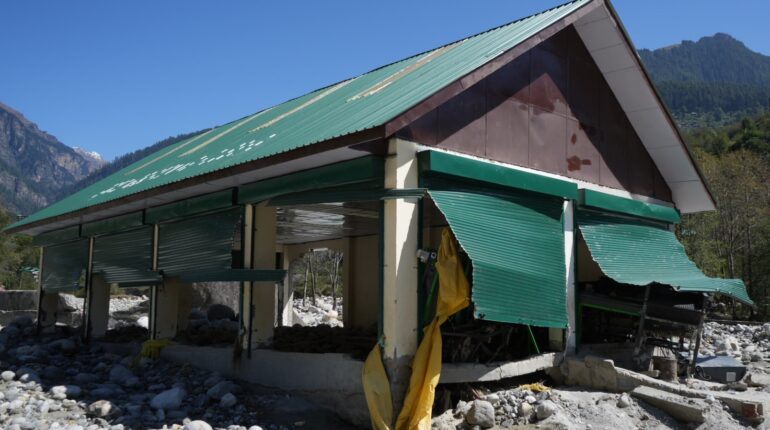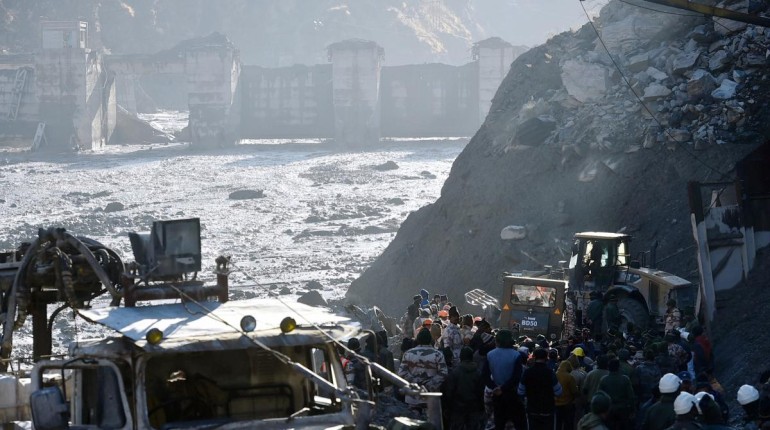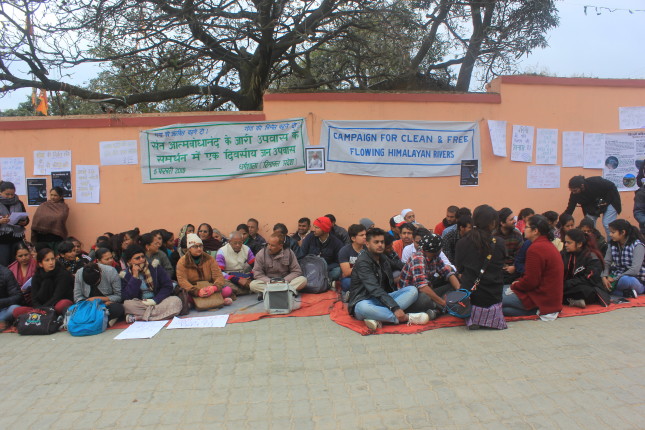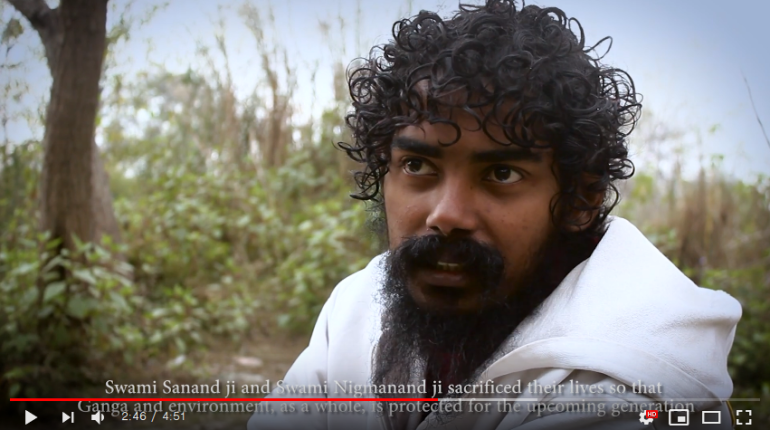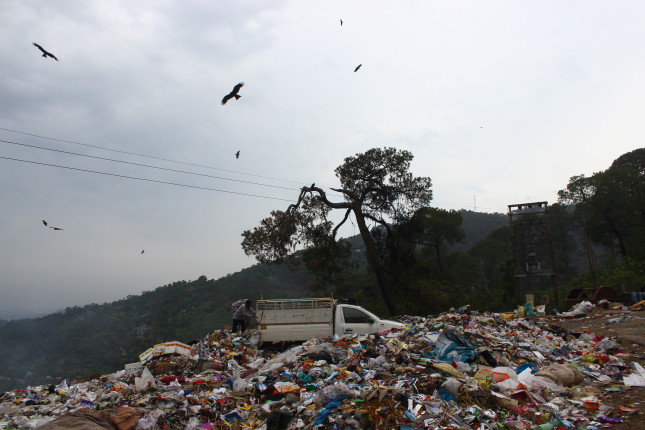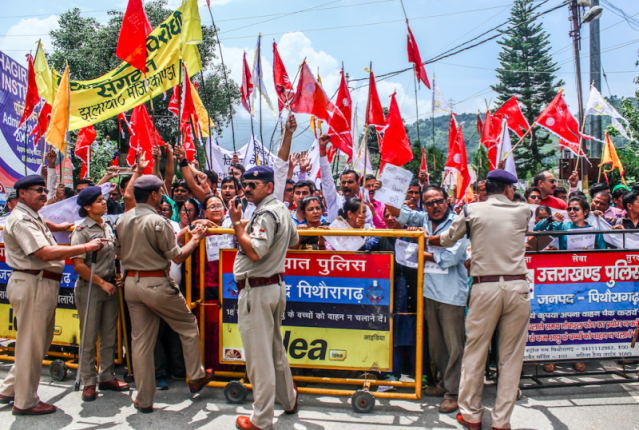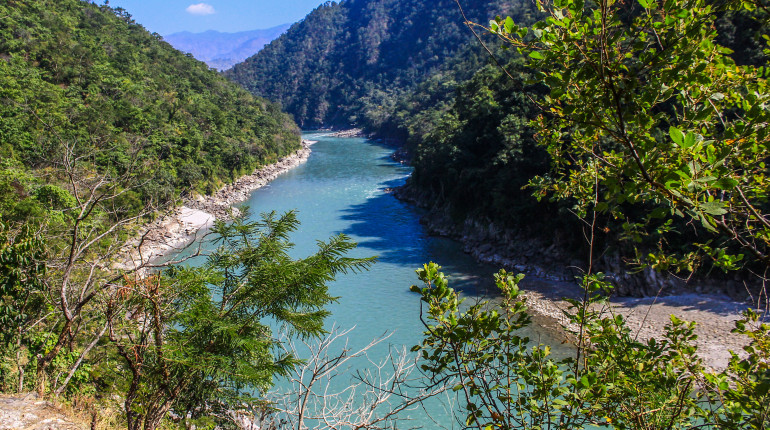Indigenous communities in the two ecologically fragile Himalayan States are routinely excluded from this narrative that fuels reckless growth. Article written by Manshi Asher published on 21/09/23 in Frontline The monsoon of 1999 is etched vividly in my memory. At 23, shortly after finishing my master’s, I was to join a project that worked on […]
Tag: Uttarakhand
Not natural but development policy induced disasters in the Himalaya! Solidarity Statement with the ongoing struggle for justice and accountability in Joshimath!
For Hindi statement scroll below.
We as representatives of diverse social organisations, environmentalists and concerned citizens from across the Himalayan region and other parts of the country, express grief and concern for the people of Joshimath, facing forced displacement from their homes in the thick of winters. Its is indeed the gravest tragedy not a mere ‘disaster’ – to witness the collapse of ones own lands. It’s a tragedy that will go down in contemporary Himalayan history, its trauma reverberating not just with the people of the entire region but across generations. Every person residing in the region who lives in areas that have seen such disasters in the last few years or is living under the threat of such displacement can relate to the distress and fear that the people of Joshimath are spending their days and nights with.
A long history of invitation to disaster
The tragedy unfolding in Joshimath has once again forced us to accept and believe that the spate of disasters we are witnessing in the Himalaya are certainly not ‘natural’ but constructed in the era of modern capitalist development. It is time that we stop fooling ourselves with myths and legends of nature’s wrath and blame fury of the gods and start facing the demons that exist in the form of our economic and political systems of governance that have brought upon us these losses. How can we turn away from the following facts that have emerged in the case of the Joshimath situation:
1. That the ancient pilgrim town of Joshimath perched at 6000 feet was already sitting on the debris of an historical landslide – a phenomena not uncommon across the Himalayan region. What we also already know is that the Himalayan ecology and geology is more varied, complex and sensitive to certain kinds of land use changes in comparison to flat regions. That close to 50 years ago the commissioner of Garhwal M.C Mishra in an official report had warned of the geological conditions of Joshimath and made recommendations for regulation on construction activity as well as protective measures in the region.
2. That the governments of erstwhile Uttar Pradesh, later (and now) Uttarakhand, as well as the local administration seems to have paid no heed to these. In the last few years a series of development projects including rampant tourism related multi-storied building, highway widening and other construction for the Char Dham Project, and a 520 MW mega hydropower dam were undertaken in and around the town. The Tapovan Vishnugad project being constructed by NTPC involves the construction of several kilometres long underground tunnel in the wake of which severe damage to local geology, hydrology and landscape has been put on record.
3. As seen across the Himalayan belt, the upper reaches are especially now witnessing the unprecedented impacts of global warming and climatic changes in the form of erratic weather patterns and reducing snow cover. The unpredictability of the resultant climatic events like floods and landslides has increased. But more importantly the changes in the land use, deforestation, the construction of dams, roads leading to slope instability, dumping of muck, deforestation and related erosion has multiplied the human and environmental impacts of these climatic events.
4. Joshimath is located in the upper reaches of the Ganga river basin in the Alaknanda valley. The neighbouring Bhagirathi river valley just ten years ago saw the massive Kedarnath tragedy that killed thousands of people. The Kedarnath flood and its aftermath were a typical illustration of what we described above – and scientists and environmental experts who studied the region presented research to establish that the unbridled construction, development footprint and the cascade of dams multiplied the impact of the flooding.
5. The most significant reports that made these linkages post the floods was the Ravi Chopra Committee report tabled in front of the Supreme Court and amongst all other recommendations it recommended a review of the proposed hydropower dams in both the Alaknanda and Bhagirathi river valleys. However, the Ministry of Environment and Forests refused to accept these and the recommendations of another committee with the same views.
6. The ambitious Char Dham highway expansion project for which a bypass was being built through Joshimath also received flak and unfavorable views from local residents, activists and environmentalists not just for the extent of erosion being caused but also because of the series of brazen violations of environmental norms especially related to muck dumping. Debris and muck dumping along rivers has emerged as the biggest contributors to flash floods, a threat for downstream areas.
7. It is shocking to note that these projects were given repeated clean chits – from the Geological Survey of India to the Ministry of Environment to the disaster management authorities nor the regional pollution control boards and forest departments – it seems that every authority had failed to execute their duties when dealing with these developments. Its even more laughable that the Municipal authorities have pointed fingers at local residents for constructing multi storey building when all authorities including the MC were complicit in granting permissions to the spate of these and much larger constructions all around.
8. In 2021 the Chamoli disaster in the Rishiganga valley upstream of Joshimath once again showed that there are multiple ways in which hydropower projects tend to act as force multipliers in disasters. The underconstruction Tapovan Vishnugad dam acted as a hurdle for the roaring flood which also swept away many workers on site of the project. It came to light that these floods also probably contributed to cutting at the toe of the mountain on which Joshimath is perched.
9. Financial Institutions like the Asian Development Bank that have funded the NTPC project and many other such large hydropower dams in the Himalaya in the name of promoting clean energy also failed to take account of possible risk from these constructions not just prior to implementation but even after the 2021 tragedy. The Bank could have carried out a detailed review of the project and the (in)adequacy of safeguards. But it did no such thing.
10. For the residents of Joshimath an added shocker was the dismissal of a Public Interest Litigation that was filed in the Nainital High bringing to light the threats posed by the NTPC project. Not only did the court dismiss the petition in the very first hearing but also imposed costs on the five petitioners questioning their motivations and credibility.
These historical developments indicate how the Joshimath was set up for the current crisis. The façade of ‘natural disaster’ and ‘All is well’.
While the current issue of widening cracks in the homes of Joshimath residents was picked up by the national media only around late December 2022, it was brought to the notice of the administration a couple of months ago, but the authorities turned a blind eye. It was when ‘Joshimath Sinking’ started trending in the social media that the district administration jumped into action. In the last month or so 850 homes have been marked with the red cross that is now etched in our minds and close to 3000 people have been evacuated. Alternative arrangements have been made for shelters in hotels with temporary relief for those who have nowhere to go. As per reports close to 30% of the town stands affected and virtually displaced and there seems to be a growing trend of cracks in the affected area.
Within days of the disaster’s unfolding the ISRO released images indicating that Joshimath had been seeing land subsidence for months and that it had sunk close to 5 cms in a matter of days in the early part of January. This could have been followed up with more regular official and public scientist accounts of what was happening in Joshimath but what we had instead was a gag order by the the NDMA – banning scientists associated with government institutions from releasing information around the disaster.
This was followed by oral statements from the Chief Minister and other representatives of the ruling party, the Chief Secretary, the State Disaster Management Authority – trying to normalise the situation and terming the event a ‘natural’ disaster. Further, when people under the banner of Joshimath Bachao Sangharsh Samiti raised slogans of ‘NTPC GO BACK’, the government came out to support the company and deny NTPC’s role in contributing to the disaster. The Uttarakhand Chief Minister has also given a statement that ‘development cannot be stopped’ amidst growing demand for an immediate halt to large scale constructions in the mountain areas as news of similar land slides and subsidence emerged in the wake of the Joshimath crisis.
Today when the displaced people of Joshimath are helplessly watching their life long savings being lost, running helter skelter to register their complaints and looking for shelter, carrying out demonstrations for their legitimate concerns – the central government should have jumped into action to hold NHAI and NTPC accountable – making them first pay for the compensation and arranging relief. The NDMA should have by now come out with a clear rehabilitation and disaster response plan under the provisions of the Disaster Management Act 2005, to be executed before the monsoons which will increase the threat of further subsidence and landslide.
- Who is accountable?
- When the so-called development projects are used to fill up company and state coffers, it is common sense that people who have borne the losses and been put to risk as a result of these developments must be considered as project affected and rehabilitated and compensated fully from this. The government must uphold the precautionary principle as well as the polluter pays principle and any rehabilitation plan must invoke the applicable central laws – the Disaster Management Act 2005 and the Right to Fair Compensation and Transparency in Land Acquisition, Rehabilitation and Resettlement Act 2013. When there is enough scientific evidence of correlations and the risks associated with such construction in young seismically active Himalayan geology – why cannot the courts take suo moto action in this matter to ensure that this is done in a timely manner and all gag orders are lifted to put the extent of the risk in the public domain so that justice to the impacted people is ensured?
- There isn’t an iota of doubt that the story of Joshimath is actually part of the novel written out for the entire Himalayan region. If justice is denied to the people of Joshimath today, there is no hope for securing justice anywhere in the Himalaya today and tomorrow. In the name of national interest, development, green energy and holy lands the top down Parvatmala policies will tie us into a thread of destructive and extractive projects from airports to highways, dams and commercial tourist centres. This does not reflect the vision nor the voice of the diverse people – especially the women, dalits and indigenous – inhabiting the mountains for whom this development is spelling more doom. The cost benefit analysis of this development agenda now stands amply visible which is why the people are seeking accountability. If these voices remain unheard a wider struggle to assert our constitutional rights will have to be built.
Article | Bahuguna and the seeds of struggle in the Himalayas
by Manshi Asher Sunderlal Bahuguna may have departed, but there are many formidable repositories of diverse oral and embodied knowledge that we could fall back on In the era of irreversible ecological destruction, initiatives to ‘save the environment’ mushroom every day. It is, after all, also the age of ‘solutions’. ‘Green’ is now a pre-fix […]
9th Feb 2021 | Public Statement | Uttarakhand Tragedy: ‘Natural disaster’ or ‘Willful Negligence’?
Scroll down for Hindi We express our grief and utmost anguish for the lives lost in the tragic event that occurred in Chamoli Uttarakhand. We hear that hundreds are missing and several feared dead. We are also aware that there is no clear statement from the government or any other State agency about the exact event […]
5th February 2019 Press Note: Solidarity fast held at Dharamshala for free flowing Himalayan Rivers; Social and Environmental activists demand to save the Ganga
Close to 100 representatives and activists of various local organizations from Kangra and other districts held a public meeting and a one day solidarity fast and public meeting on “Clean and Free Flowing Himalayan Rivers” at Dharamshala on 5th February, 2019 outside Hanuman Mandir from 10 am to 4 pm. The fast, led by veteran […]
Video: A clarion call to free the Ganga
On the 100th day of fasting by Ascetic Atambhodhanand, a 26 year old engineering drop-out, for clean and free-flowing Ganga, we share with you his message to join the movement. To lend solidarity to the cause, we urge you to circulate this widely. https://www.youtube.com/watch?v=wYUzA2RugAA&feature=youtu.be
पश्चिमी हिमालय में पर्यावरण समावेशी व समुदाय-आधारित पर्यटन स्थानीय समुदायों के लिए कार्यशाला
पश्चिमी हिमालय में पर्यावरण समावेशी व समुदाय-आधारित पर्यटन स्थानीय समुदायों के लिए कार्यशाला 31 अगस्त से 3 सितम्बर, 2018 संभावना संस्थान, पालमपुर, हिमाचल प्रदेश पृष्ठभूमि भारत में पर्यटन की नीतियाँ पर्यटकों की मांग को केंद्र में रखते हुए और निजी व्यवसायियों के मुनाफे को अधिक से अधिक बढाते जाने के उद्देश्य से बनाई जाती हैं, जिससे […]
There Are Ecological Limits to Growth – Just Look at Himachal Pradesh
As the state’s situation worsens, the only two choices in front of the Himachali people will be mass agitation or mass exodus. Himachal Pradesh is located in the region of the world considered to be the water tower of the Indian subcontinent. But what happens when the high mountains – repositories of snow and thus […]
What Lies Behind the Resistance to India’s Highest Dam?
Not only has the government failed to do a cost-benefit analysis of building the Pancheshwar Dam or assess its environmental impact, it has also fallen short of addressing the growing concerns of locals. Exactly a year ago, our prime minister, in his campaign speech just before the Uttarakhand state elections, declared from the podium in Pithoragarh town that […]
पै्रस विज्ञप्ति: पंचेश्वर बहुद्देशीय नही बहुधोखीय परियोजना है
5 November 2017 पंचेश्वर बहुद्देशीय नही बहुधोखीय परियोजना है: पंचेश्वर बांध व रुपालीगाड बंाधों की प्रक्रिया तुरंत प्रभाव रोकी जाये। वन अधिकार दो – जैव विविधता रजिस्टर ग्राम स्तर पर बनाओं प्रभावित जनता को अंधेरे में रखकर पर्यावरण और वन स्वीकृतियंा लेने की प्रक्रियंा पूरी की जा रही है वह यह बताता है कि सरकारों […]

